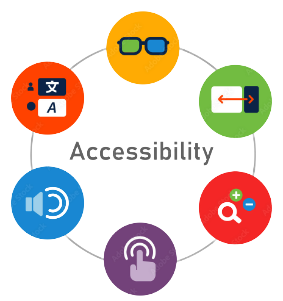Designing accessible mobile apps should not be viewed as a one-time checklist item, but as an ongoing commitment to making technology more inclusive and accessible for all users. By prioritizing accessibility, businesses can create mobile apps that provide a positive user experience.
In today’s digital age, mobile apps are ubiquitous, providing users with access to various services and information. However, not all mobile apps are created equal when it comes to accessibility. Accessibility refers to designing mobile apps that can be used by people with disabilities, such as those who are visually or hearing impaired. Accessibility in mobile app design is crucial to ensure that all users can access and benefit from your app. In this article, we’ll explore the importance of accessibility in mobile app design, best practices, and challenges.
Importance of Accessibility in Mobile App Design
Mobile app accessibility means that all users, regardless of ability or disability, can use the app with ease. Inclusive design is not only a legal requirement but also a moral obligation to provide equal access to digital products and services. By making your app accessible, you’re opening it up to a broader audience, which can improve your app’s user engagement, increase customer loyalty, and boost your brand’s reputation.

Best Practices for Accessibility in Mobile Apps
-
Follow Accessibility Guidelines
The first step in creating an accessible mobile app is to follow accessibility guidelines such as the Web Content Accessibility Guidelines (WCAG). These guidelines provide a comprehensive set of recommendations to make web content, including mobile apps, more accessible. Following these guidelines ensures that your app can be used by everyone, regardless of their ability or disability.
-
Use Clear and Simple Language
Using clear and simple language is essential for making your mobile app accessible. Avoid using jargon or complicated language that may be difficult to understand. Use simple sentences and words that are easy to read and comprehend. Consider adding audio and video content to supplement the written text.
-
Provide Multiple Ways to Navigate the App
People with disabilities may use different ways to navigate the app. For instance, some users may use a keyboard instead of a touch screen, while others may use voice commands. It’s essential to provide multiple ways to navigate the app, such as keyboard shortcuts, voice commands, and touch gestures.
-
Use High-Contrast Colors
Using high-contrast colors is vital for users with visual impairments. It makes it easier for them to distinguish between different elements on the screen. Ensure that the text is easy to read and that there is enough contrast between the background and foreground colors.
-
Make Sure Your App is Keyboard Accessible
Some users may not be able to use a touch screen, so it’s essential to ensure that your app is keyboard-accessible. Keyboard accessibility means that all app features can be accessed using a keyboard alone, without requiring any mouse clicks.
Challenges of Mobile App Accessibility
-
Keeping up with the Latest Technologies
The mobile app industry is continually evolving, and keeping up with the latest technologies can be challenging. As new technologies emerge, it’s crucial to ensure that they’re accessible to all users, including those with disabilities.
-
Balancing Accessibility with Aesthetics
Creating an accessible mobile app doesn’t mean compromising aesthetics. However, it can be challenging to balance accessibility with aesthetics. It’s essential to strike a balance between the two, ensuring that the app looks good while remaining accessible.
-
Limited Accessibility Testing Tools
There is a limited number of accessibility testing tools available for mobile app development. It can be challenging to test the app’s accessibility manually, which can be time-consuming and costly.
Conclusion
Creating an accessible mobile app is critical for ensuring that all users can access your app’s content and features. In addition to the moral and legal imperatives of accessibility, creating accessible mobile apps can also benefit businesses by increasing their user base, improving user satisfaction, and enhancing brand reputation. As the mobile app market continues to grow and competition intensifies, creating accessible mobile apps is becoming a key differentiator for businesses.
Overall, designing accessible mobile apps should not be viewed as a one-time checklist item, but as an ongoing commitment to making technology more inclusive and accessible for all users. By prioritizing accessibility, businesses can create mobile apps that provide a positive user experience for all, regardless of their abilities or disabilities.
At Tanbits, we follow accessibility guidelines, use clear and simple language, provide multiple ways to navigate the app, use high-contrast colors, and make the app keyboard accessible to ensure that our mobile apps are accessible to all users. We balance accessibility with aesthetics, keep up with the latest technologies and user needs, and test for accessibility throughout the design and development process. Contact us to learn more about our mobile app development services and how we can help you create an accessible mobile app.
BACK










